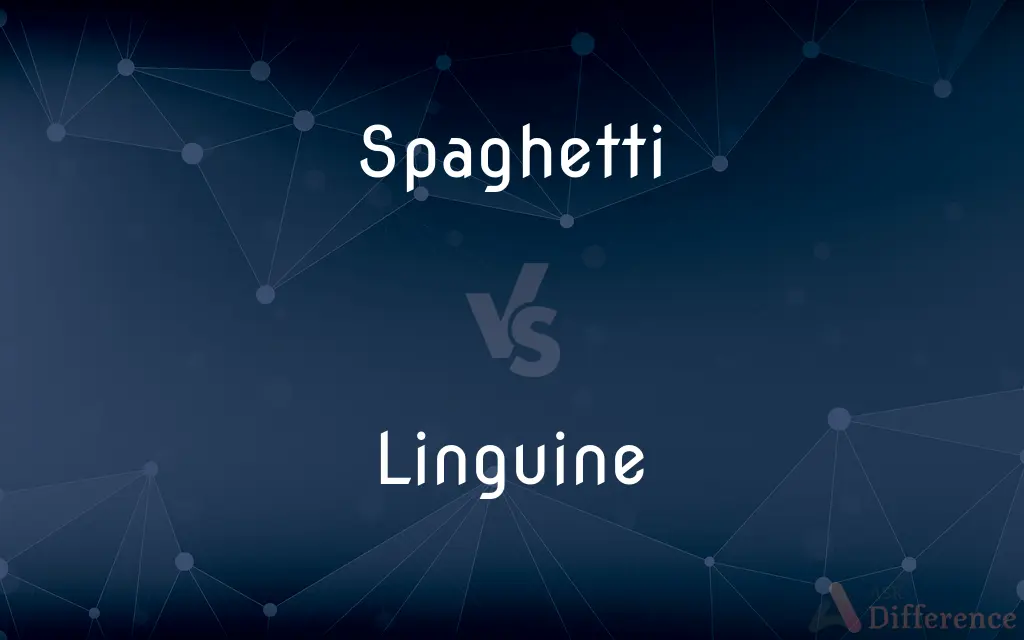Spaghetti vs. Linguine — What's the Difference?
Edited by Tayyaba Rehman — By Fiza Rafique — Updated on October 29, 2023
Spaghetti is a round, long pasta, while Linguine is flat and slightly wider. Both are traditional Italian pastas but differ mainly in shape.

Difference Between Spaghetti and Linguine
Table of Contents
ADVERTISEMENT
Key Differences
Spaghetti is one of the most recognized forms of pasta and is characteristically long and thin with a round cross-section. Originating from Italy, this pasta is used in a variety of dishes, often paired with marinara, meatballs, or carbonara sauces. Linguine, on the other hand, is also long but has a flatter, wider profile, resembling narrow ribbons.
Spaghetti is typically made from durum wheat semolina and water. Its cylindrical shape makes it versatile and a favorite in many traditional Italian and Italian-American dishes. Linguine, while similar in ingredients, stands out with its elliptical cross-section, giving it a different texture and bite when cooked.
When served, Spaghetti often pairs well with thicker sauces due to its round shape which holds onto the sauce efficiently. Linguine's flatter structure makes it more suitable for lighter, more delicate sauces, like clam sauce or pesto, as the sauce clings to the wider surface.
In terms of popularity, Spaghetti might have a slight edge, especially in the U.S., due to its iconic association with dishes like spaghetti and meatballs. Linguine, though slightly lesser-known, holds its own with seafood dishes, where its shape complements the textures of ingredients like shrimp or clams.
While both Spaghetti and Linguine share similarities in ingredients and origin, they offer distinct culinary experiences. The choice between Spaghetti and Linguine often boils down to the sauce pairing or personal texture preference, as each provides a unique mouthfeel.
ADVERTISEMENT
Comparison Chart
Shape
Round and long
Flat and slightly wider
Cross-section
Cylindrical
Elliptical
Popular Sauce Pairings
Thicker sauces like marinara or meat sauces
Lighter sauces, especially seafood-based ones
Texture when Cooked
Consistent cylindrical bite
Flatter with a wider bite
Common Dishes
Spaghetti with meatballs, spaghetti carbonara
Linguine with clam sauce, linguine with pesto
Compare with Definitions
Spaghetti
A long, thin, cylindrical pasta of Italian origin.
She cooked spaghetti for dinner tonight.
Linguine
A type of pasta resembling narrow ribbons.
She paired the linguine with a light garlic sauce.
Spaghetti
A staple in Italian and Italian-American cuisine.
When in Rome, they enjoyed spaghetti at a local trattoria.
Linguine
Often used in traditional Ligurian dishes.
Linguine with pesto is a popular dish from the Liguria region of Italy.
Spaghetti
A type of pasta often served with meatballs in America.
Spaghetti and meatballs is a classic dish in many American households.
Linguine
A pasta with an elliptical cross-section.
When cooked, linguine offers a unique mouthfeel due to its shape.
Spaghetti
Spaghetti (Italian: [spaˈɡetti]) is a long, thin, solid, cylindrical pasta. It is a staple food of traditional Italian cuisine.
Linguine
A favorite choice for sauces with delicate textures.
The linguine paired perfectly with the clam sauce.
Spaghetti
Pasta made in solid strings, between macaroni and vermicelli in thickness.
Linguine
Italian pasta that's wider than spaghetti but narrower than fettuccine.
Linguine is often chosen for seafood dishes.
Spaghetti
Pasta in long, often thick strands.
Linguine
Linguine (; Italian: [liŋˈɡwiːne]) is a type of pasta similar to fettuccine and trenette but elliptical in section rather than flat. It is about 4 millimetres (0.16 in) in width, which is wider than spaghetti but not as wide as fettuccine.
Spaghetti
(Electricity) A slender tube of insulating material that covers bare wire.
Linguine
Small pieces of pasta in the form of narrow ribbons.
Spaghetti
A type of pasta made in the shape of long thin strings.
Linguine
Pasta in long, flat, thin strands.
Spaghetti
(by extension) A dish that has spaghetti as a main part of it, such as spaghetti bolognese.
Linguine
Of pasta, cut from a sheet, not as wide as tagliatelle.
Spaghetti
(informal) Any type of pasta.
Linguine
Pasta in long slender flat strips
Spaghetti
(informal) Electrical insulating tubing.
Spaghetti
(informal) Anything tangled or confusing.
Spaghetti
(countable) A spaghetti western.
Spaghetti
Spaghetti code.
Spaghetti
To become, or appear to become longer and thinner.
The cables spaghettied onto the shoulder of the technician.
Spaghetti
To stretch to become longer and thinner.
He spaghettied the referee when he landed on him.
Spaghetti
A variety or macaroni made in tubes of small diameter.
Spaghetti
Pasta in the form of long strings
Spaghetti
A dish primarily consisting of spaghetti pasta and a chosen sauce.
Spaghetti with marinara sauce is his favorite.
Spaghetti
Italian pasta made from durum wheat and water.
Authentic spaghetti has a distinct taste and texture.
Common Curiosities
What's the primary difference between spaghetti and linguine?
Spaghetti is round and long, while linguine is flatter and slightly wider.
Can I substitute linguine for spaghetti in recipes?
Yes, but the texture and sauce pairing might differ slightly.
Do spaghetti and linguine cook in the same amount of time?
Generally, yes, but it's always best to refer to the pasta's packaging for precise cooking times.
Which pasta is more popular in the U.S., spaghetti or linguine?
Spaghetti is arguably more popular, especially with iconic dishes like spaghetti and meatballs.
What sauces pair best with linguine?
Linguine often pairs with lighter, seafood-based sauces.
Is spaghetti always made from durum wheat?
While traditional spaghetti is made from durum wheat, variations can include other ingredients.
Are there gluten-free versions of spaghetti and linguine available?
Yes, many brands offer gluten-free options for both pastas.
Are both spaghetti and linguine of Italian origin?
Yes, both pastas originate from Italy.
Which is thicker, spaghetti or linguine?
Linguine is wider due to its flat shape, while spaghetti is cylindrical.
Which pasta is best for a carbonara, spaghetti or linguine?
While both can be used, spaghetti is traditionally used in carbonara dishes.
Which pasta would be better for a clam sauce, spaghetti or linguine?
Linguine is often the preferred choice for clam sauce due to its shape.
Is spaghetti always served long, or can it be broken?
While traditionally served long, some people break spaghetti for certain recipes or for ease of eating.
Is spaghetti the thinnest pasta available?
No, there are thinner pastas like angel hair or capellini.
Which region in Italy is linguine most associated with?
Linguine is closely associated with the Liguria region.
Can I use the same pot to cook spaghetti and linguine?
Yes, as long as the pot is large enough to accommodate the pasta and water.
Share Your Discovery

Previous Comparison
Process vs. Progress
Next Comparison
Splade vs. SporkAuthor Spotlight
Written by
Fiza RafiqueFiza Rafique is a skilled content writer at AskDifference.com, where she meticulously refines and enhances written pieces. Drawing from her vast editorial expertise, Fiza ensures clarity, accuracy, and precision in every article. Passionate about language, she continually seeks to elevate the quality of content for readers worldwide.
Edited by
Tayyaba RehmanTayyaba Rehman is a distinguished writer, currently serving as a primary contributor to askdifference.com. As a researcher in semantics and etymology, Tayyaba's passion for the complexity of languages and their distinctions has found a perfect home on the platform. Tayyaba delves into the intricacies of language, distinguishing between commonly confused words and phrases, thereby providing clarity for readers worldwide.
















































